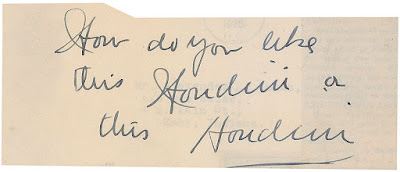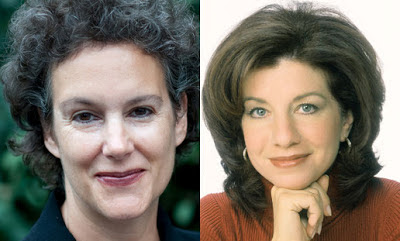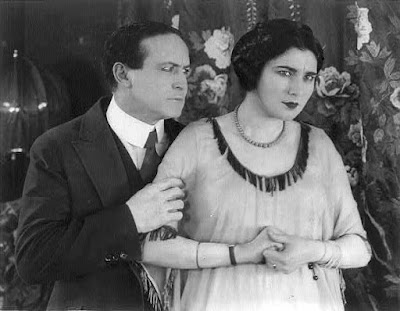Today we have a special bonus to wrap-up our week-long journey through the private Libbet Crandon de Malamud Collection, or what I've been calling, "The Margery Files". Here's an exclusive interview with our generous patron, Anna Thurlow, the great granddaughter of Mina Crandon aka "Margery the Medium."
WAH: First, thank you for allowing me to share these amazing items from your family archive on my blog. Can you tell me how you came to have these treasures, especially Margery's seance kimono? That's an incredible piece of Spiritualist history!
ANNA: Thank you; it has been a pleasure collaborating with you on this week’s project. It is wonderful to be able to share some of these items with an audience that can truly appreciate them and can help put them in their larger historical context.
 |
| Libbet Crandon de Malamud |
I inherited the collection from my mother, Libbet Crandon de Malamud. She was an anthropologist. When she was diagnosed with cancer at the age of 42 she realized that she would no longer be able to conduct field work, and she thought that she would finally have the opportunity to write about her grandmother, Margery. My mother was always fascinated with Margery and raised me on stories about her. My mother asked her father for his permission to write the book (he was intensely shy and reticent to talk about his mother). To her surprise, he not only supported the idea but gave my mother the papers he had stored up in the attic for 50 years, and this is the core of the collection. Other items, such as the kimono, were also left to me by mom. I think she might have worn it a few times (I have as well, to a several of Sid Radner’s séances).
My mother did not live to write her book. Just before she died, she asked me to write it for her. I named the collection after her, since by all rights it should have been my mother talking with you right now and sharing these documents. She would have loved every minute of this discussion!
WAH: Do you have any idea what happened to other famous Margery-Houdini artifacts like the Bell Box and the "Margie Box". Also, it's said that Dr. Comstock constructed a second control apparatus for the final seance. Any idea what happened to that, or have you ever see a photo of it?
ANNA: Unfortunately, I do not. I don’t think the Margery Box would have ever been in her possession, since Houdini built it, and although I am not familiar with the Comstock apparatus my guess would be that Comstock kept it. I suspect that these items remained in the hands of the researchers and sitters since these were items used
on her, not
for her.
The basic items in her séance room – a table, cabinet, bell box, and chairs – probably existed at 10 Lime Street until the family sold the home in the 1940’s. Since Margery’s mediumship began as intimate, domestic affairs and many of her “props’ were essentially household items, these things probably just faded back into the house and disappeared with time. The chairs that I have, for example, were sitting in a back bedroom at my grandparents house for years and no one particularly wanted them, except me. For me these are very personal items and all that is left of that side of my family, so I have made an effort to preserve, document and understand them.
WAH: There are rumors that Margery and Houdini had an affair or were otherwise somehow in collusion. Willard Green tells a story of how he saw Houdini and Margery riding together in Houdini's car the day after the seance. Have you ever gotten any sense that there was anything fishy going on between Houdini and Margery?
ANNA: I think the reason why the idea of them having an affair is so compelling is that it seems like there was an undeniable connection between them. What form or depth that connection had, I do not know. But they shared a lot in common and that still somehow comes across today.
A big difference between them however was that whereas Houdini identified early on magic as his career of choice, and spent a lifetime perfecting his craft and developing a concrete philosophy around it, Margery’s mediumship began as an intimate affair for her family and close friends, and it evolved into something over which she did not have full control. There were very few intellectual outlets for women at that time, and spiritualism was a way for women to become “explorers into the unknown” without having to leave the intimacy of their own homes. It was not uncommon for middle class women to hold séance circles (although it was uncommon for them to actually be the medium). Margery did not seek out publicity or fame. Margery is not even her real name, but her nome de séance, which she requested from the
Scientific American to protect her identity when the Committee asked to investigate her. Dr Crandon, however, loved the attention and he created a second career for himself based on her mediumship. I find it remarkable and inspiring how she continually transformed the mediumship into something uniquely her own, despite the fact that she was not always the agent of it. I have come to think of her as a performance artist whose art grew organically as a reaction to her surroundings.
I imagine that when she met Houdini there must have been a strong sense of kinship. But she probably did not understand Houdini’s professional approach to his work – that would have been so far outside of her own based of reference. She probably had no idea that he would incorporate her exposure into his own performances. Naïve of her, but perhaps that is why her sense of betrayal was so great.
WAH: Okay, the big one: Who put the ruler in the Margie Box?
ANNA: I was always told that Houdini placed the ruler in the Margery Box. Margery was devastated. When Houdini exposed her methods, my grandfather (he would have been about 12 at the time) went out at night and bought all the newspapers in Boston so that his mother would not read about it.
WAH: In doing this series and re-reading the sections on Margery in the major Houdini bios (and talking to you), I can't help but get a sense of the extreme control Dr. Crandon had over her. Do you know how she felt about this? Was she comfortable being "Margery the Medium"? Do you think maybe she saw Houdini and his ability to expose her as a possible liberation from this life?
ANNA: This is an excellent question.
 |
| Dr. Crandon and Mina |
There is no doubt that the Crandons had a complicated relationship: there was a great disparity in age, education and background, and she was his third wife. I think Margery struggled at first to earn Dr Crandon’s respect and that of his well educated, society friends. He also had a habit of divorcing his wives after a few years. It was a few years into their marriage when Margery began the séances, and as Ken Silverman says in his book about Houdini, Margery probably began them in part to keep Dr Crandon’s attention as well as to alleviate his morbid fear of death. One of the things that made Margery’s séances remarkable was that they were an occasion for joy and playfulness: table raps sounding out the musical refrain of Taps, victrolas turning on in the dark to play European waltzes, floral scents floating through the air, a dancing table that led the entire séance group down the stairs, and all with the friendly, rough and tumble voice of Walter, Margery’s dead brother.
The stakes changed, however, when Margery’s mediumship caught the attention of famous people such as Arthur Conan Doyle and the committee members of the
Scientific American. Suddenly she was subject to the scrutiny of scientists and investigators, and had to devise means to incorporate and satisfy scientific controls around the séance. This became a defining characteristic of her mediumship as her séances were subject to a dizzying array of tests, committees, and contraptions. Funnily enough, the séances that Houdini attended were the least interesting, in my opinion. In period of 1926-1929 she produced wax fingerprints of spirits, psychic paraffin hand molds, footprints of unborn babies (a bit creepy), automatic writing in foreign languages such as ancient Chinese and Japanese, and the Cross Correspondences (whereby seances were held at the same time in different cities and fragments words were received, which, when combined, formed a full sentence). It has been suggested that Dr Crandon was coercive in forcing her to conduct séances even when she didn’t want to, and I think that is true. She certainly seems to have become quite bitter in her later years, and tried to commit suicide during one séance by attempting to jump off the roof of 10 Lime Street. She did ultimately kill herself through alcoholism and died on November 1, 1941 at the age of 51 (only one day after the anniversary of Houdini’s death, coincidentally – and I’ve heard that she predicted the day of her own death). So I think one can definitely say that she had conflicted feelings about the path her life took.
I certainly do not see her as a victim, however. I think one thing that has gotten lost in the written history is that what she produced in the séances was often quite beautiful, and fun. She took on an intellectual challenge and certainly gave the investigators a great show. I would like to think that she derived some sense of satisfaction from that.
 |
| Mina Crandon's own copy of "Margery" the Medium. |
Thanks again to Anna Thurlow for providing us with such a memorable and fascinating week. The good news is it isn't over just yet. We still have one last unique item to share, so watch out for
The Margery Files Revisited coming soon.
The Margery Files:


































.JPG)

















